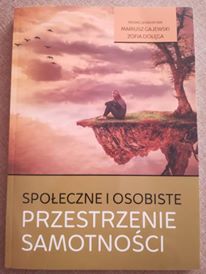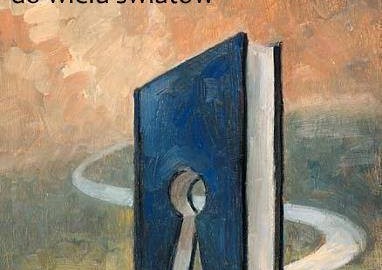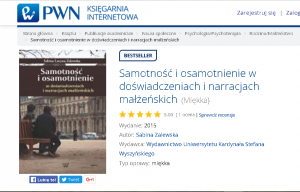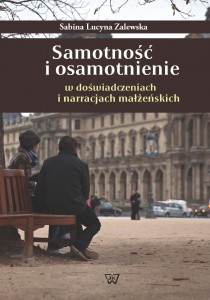 Loneliness and solitude in marital experience and narratives
Loneliness and solitude in marital experience and narratives
The subject of this study concerns marital relationships and focuses on the issue of isolation (solitude) and loneliness of the spouses.
This issue is extremely timely given the ongoing socio-cultural transformations and expansion of the culture of individualism affecting the nature of interpersonal relations and due to the manner of performing various social roles, including in particular the important marriage and parenting roles. This raises particular challenges for the theory of pedagogical practice and psychology. These studies also are part of a series of research studies on marriage and family led by: A. Kwak, M. Nowak-Dziemianowicz, M. Plopa, A. Giza-Poleszczuk B. Harwas-Napierała, D.H. Olson, R. Markoff, R. Buttiglione, A. Faber and E. Mazlich.
My analysis contained in the monograph subject to assessment: Loneliness and isolation in marital experience and narratives can become a tool for further exploration in the field of research on the functioning of marriage and family. In my experience as a researcher, I explore the research methodology combining qualitative and quantitative research methods. I analyse the aspects of marital and family life from the perspective of the theory of symbolic interactionism, which is one of the few (though rarely commonly used[1]) trends in family and family life analyses. It derives from the so-called Chicago School, whose representatives are: G.H. Mead, H. Becker and today it is related to the neointeractionism of B. Glaser and A.L. Strauss. School of symbolic interactionism can be placed within the interpretative paradigm. In symbolic and interactive trend, the basic concepts are: relationships, status and a role. I present here the family as unity – the unity composed of persons exercising influence on each other. This mutual interaction is carried out by performing the roles. It is described by such concepts as: sense of community, cohesion, stability, solidarity, order and relative permanency.
The community nature of marriage, however, does not deny an individual way of spouses in the development process (theory of the „Life Race” Ch. Bühler). The shared space embraces the individual living spaces of the spouses: a common space for them, their meeting space and the space completely autonomous. In fact, their existence constitutes the existence of community relationship. Non-existence of these spaces can lead to the feelings of loneliness and isolation. This concept is visualised on the figure presented below.
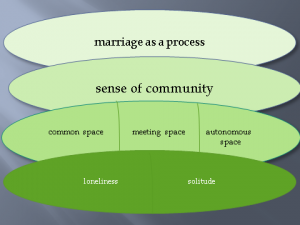
Fig. Marriage as a process versus loneliness and solitude
At the point of contact of these spaces, but rather within their boundaries, there appears a problem of loneliness and isolation in marriage. This problem seems to be very interesting and topical. Not so often picked up by the authors in their deliberations on various aspects of conjugal and family life.
The theoretical and descriptive part of work consists of two chapters. I explain and distinguish in them the concept of „loneliness” and „isolation”. I analyse in them the concept of loneliness in three dimensions: theological, psychological, and philosophical.
It was very crucial to distinguish between these phenomena and accurately define them. Loneliness is understood in my work as a good phenomenon for a man, contributing to their growth and development, but at the time experiencing it, it is often tinged with feelings of pain and suffering. As a result, contributing to their internal integration and identity building. Loneliness is also understood (especially in relation to married life) as an essential right to have their own separate living space, to which no one has access. This is important for the individual, especially because of their mental hygiene. On the other hand, the isolation is understood as a negative phenomenon, destructive to human, involving severe feelings, difficult and even impossible to overcome. In contrast to loneliness it does not bring benefits for a man, nor for the development. It contributes to the disintegration of their personality. Getting out of it requires long and arduous work. It always leaves a man suffering with a number of traumas. Often requires therapeutic work or ends in suicide. The works of authors who have made a profound reflection on loneliness and solitude helped greatly to reach this distinction: T.W. Adorno, J.G. McGraw, P. Tillich, Z. Dołęga, E. Dubas. Dissimilarity in this work is the precise distinction between these concepts, their definition and description.
A theoretical framework of work relates to the family seen as a biographical and communicative process. This process is the result of experience and the history of marriage and family life. Marriage and family are subject to change. They have never been, are not and will not be static organizations[2].It is a process based on communication, biographiness and interaction. Marriage, as relationship of special nature, creates a broad base for marital interactions: spiritual, mental, sexual and economic. All members of the family create a complicated system of interactive relations based on bonds of two kinds: marital and parental.
I am a close follower in my thinking of what Ch. Bühler and A.W. Janke are saying that the developmental changes of the spouses result from their mutual interaction and are affecting reversely the functioning of the network of relationships and communication in marriage, therefore one can say that the essence of developmental changes of marriage is based on the circular dependencies. The theory of the development of marriage and family is associated with the development throughout the entire life. The development of marriage and family can be described as a series of stages that include a full range of events and challenges emerging in the lifetime for all its members. These stages are determined usually by changing the number of members (as a result of births, deaths or leaving the family home), the stages of development of children or by linking the family with other social systems, for example a family member’s transition into retirement. This allows us to draw a predictable chronology of stages of family life.
In the second part of this work I characterize the methodological framework of the study. The subject and method of study is here the biography of marriage. The biography includes spouses’ experience that reveal and explain themselves in their narratives. The advantage of the biographical method is that personal documents provide insight into the motivation, aspirations, attitudes and assessments that people form. This material captures the psychological side of the functioning of social institutions, the formation of public opinion. It provides the ability to describe the mutual relationships between: the environment and the individual, the individual and the individual, the culture and the individual. This material allows to capture some sequences of the events (the causal relationships in the long term). This material also provides information about how people cope in situations of social change. The biographical perspective is therefore extremely useful for the analysis of loneliness and solitude in marriage, especially in the context of marital experience.
The purpose and subject of the research discussed in this paper is loneliness and solitude in marriage, as one of the marital experiences. These states are experienced by both spouses at different stages of their lives and the duration of their relationship. Therefore, the following questions of a problematic nature have arisen:
- What spouses’ experiences indicate the experiencing and feeling of loneliness in marriage?
- At what point does the loneliness in the relationship start?
- How loneliness is associated with the myth?
- In what myths the loneliness is being reflected?
- What spouses’ experience does it relate to?
- What significance for loneliness and solitude in marriage has the fact that both family and marriage is of processual/staging nature?
- Is loneliness necessary for the development of the spouses?
- What are the sources of loneliness and whether they have an effect on marital relations?
- What is the sense of loneliness in marriage?
- Is the loneliness a value in the relationship and do the spouses discern this value?
- Is it justified to separate the discernment of solitude and loneliness?
- What distinguishes these two phenomena in the narratives of the respondent spouses?
The qualitative and quantitative terms matter to me purely symbolically (as for N.K. Denzin and Y.S. Lincoln[3], T. Bauman and T. Pilch[4], K. Konecki[5]) because in qualitative research also some calculations are used, and in quantitative research the qualitative analysis of the data is made. Therefore, I have not embarked on research with ready-made hypothesis and the net of terms, mainly:
- not to impose on the respondents my category, perception of the world (since it is their vision of reality that is important);
- minimize the risk of self-acknowledgement of theory, namely the situation in which the response (the result of investigation) would be de facto contained in the question that was asked. Therefore, my hypotheses are of rather argumentative nature (for which only the conditions for their occurrence were established) rather than the tested statements, although they are verified during research and generate theories[6]. Therefore, they appear in my work in the course of analysis of the research material.
In exploring the phenomena of loneliness and isolation especially useful perspective is existential psychology and pedagogy with the use of biographical research with the use of narrative and hence the research being part of qualitative methodology.
The specificity of the subject determines and even imposes the selection of the method. As a result, I applied in my research: biographical narrative interview, Desk Research – the analysis of secondary sources, Storytelling and Method of Confrontation with Myself. The research I conducted in phases in the total group of 158 persons, obtaining extensive empirical material. I devoted considerable attention to the description about how the data were collected.
On the basis of the gathered findings, I identified the categories related to:
- mythology of married life – this category has appeared in many narratives. Even if the respondents did not separate it very clearly in their own stories and experiences, it appeared in the sideline stories. Often as a punch line, reflection or their summary. Despite the fact that this category had a direct link with the functioning and describing the relationship within the meaning of anthropology, culture or even vague social reasoning, the narrative material turned out to be very interesting and rich. The material in this category comes from the material collected and developed by means of methods: „Biographical narrative interview,” „Desk Research – Analysis of secondary sources” and „Storytelling”;
- dynamic nature of marriage (marriage as a process) – this category is related to the representatives of all stages of married life. The multitude of categories separated in the description of the group in terms of seniority of married life, helped to make observations that among the respondents there are representatives of all the stages of married life, which made it possible to trace and isolate narratives and stories in this category. This became the source of many marital experiences, confirming the process-related nature of marriage. The material in this category comes from the material collected and developed by virtue of methods: „Biographical narrative interview,” „Desk Research” – Analysis of secondary sources” and „Storytelling”;
- sources of solitude – the only category which in whole refers to the analysis of the research material obtained by „Method of Confrontation with Myself”. This category describes four sources of loneliness, which are deeply rooted in the experiences of the respondents and very clearly positioned in the social and internal space.
- sense of loneliness – this category affects the research question related to the sense of loneliness. The material presented here is extremely rich. It touches the deep experience of the spouses. The presented narratives relate to very deep experiences in the relationship. These are very intimate and emotional narratives. The content in this category is derived from the material collected and developed by methods: „Biographical narrative interview,” „Desk Research – Analysis of secondary sources” and „Storytelling”;
- loneliness in the relationship – the category referring to the narrative related to hard and very distressing marital experiences for the spouses. It is associated with one of the objectives of my work, distinguishing between loneliness of solitude. The material in this category comes from the material collected and developed by methods “Method of Confrontation with Myself”, „Biographical narrative interview,” „Desk Research – Analysis of secondary sources” and „Storytelling”.
An important objective of the presented studies is the belief that language is a reflection of history and human experience, reveals the structure of man’s individual, personal experience. The narrative built by the person is for me the portraying of the system, its subjective meanings, selected and arranged according to certain rule, the propriety of certain facts for the respondent. Combined in the personal narrative, the autobiographical memory and self-understanding allows deep reflection about own interaction with the spouse, relationships and marriage.
Loneliness in relationship, according to narrative research presented in this work, often occurs at the interface of community space and own space. Often, that’s where a number of marital myths functions, of which putting into practice results in one party’s experiencing loneliness in the relationship. All the narratives of the respondents were associated with great emotionality of expression and experience. Loneliness and solitude in marriage is something that stimulates reflection and discussion. Repeatedly surveyed respondents in their narratives undertook such actions. They often stressed out that the mere existence of loneliness in their life led to self-reflection on themselves and their behaviour. In the light of these considerations and experiences of the respondents the thesis was formulated that the loneliness is linked with human life. A man is not able to escape from it, or protect against it. They should rather try to accept it and make use of it. The research material, especially narrative, provided the basis for a lot of interesting analysis. Very interesting material concerned the myths of marriage. They proved to be a source of loneliness, frustration and disorder in conjugal relations. Such false beliefs that circulate as the „life wisdom” or common beliefs contribute to unrealistic expectations in relation to marriage and the spouse. They disrupt the real grasp of the situation and focus all energy on fairy-tale vision of marriage relationship.
As I have already pointed out, marriage is for me of procedural/staging nature. The same is with phenomena occurring in each of its stages. In each of the stages of married life, according to research, the spouses experience loneliness. Of course, at each stage it has other source and other characteristics. This is mostly linked to the history of married life and often becomes a resultant of actions taken in marriage and the roles taken by the spouses. In the light of these considerations, the thesis was formulated, which states that loneliness changes a man and their view on the current situation and their relationships. The marriage narrations show clearly that, although the experienced loneliness is associated with a heavy load of negative feelings, if the spouses are working on it, it changes its negative character and directs relationship into positive reinforcement. Processuality of the relationship makes possible to rework this experience and use it as intrusive element of marriage.
The sources of the emergence of loneliness have big and significant effect on marital relations. In the narratives of the respondents there appeared a strong relationship between the causes of loneliness and the experienced negative feelings. The respondents experience helplessness, suffering, pain, distraction of feelings of longing. It is difficult experience for them, which they cannot measure and re-orient their reference to work on it. Sometimes, such work seems impossible because they do not accept people giving them support (therapists, spouses, family). This does not mean, however, that the couples are completely lost in their suffering associated with loneliness. In many narratives they clearly showed a desire to work or even sort out the problem. When this has already happened, they perceived loneliness as positive experience which strengthened their relationship. Therefore, it was important for the respondents to make a distinction and discernment between solitude and loneliness. This need was the next thesis of the work: solitude is different than loneliness.
The analysis of the marriage narratives and reflection of the respondents associated with loneliness in the relationship showed its deep meaning. The presence of loneliness in their married life indicates the positive impact of this experience on the marital integration and closeness, provided, however, that the spouses re-work their negative feelings arising with this experience. Loneliness could have creative or destructive dimension. The first one should cherished and one should learn from it, while the latter should be eliminated or the help in overcoming it should be sought. The creative dimension of loneliness is achieved through becoming calmed down, reflection, meditation, often in solitary confinement. Today’s world, through its great dynamics triggers the noise, aggression, rush, so one should learn how to contemplate and reside in silence. However, the calming down of a man cannot mean sentencing them to non-tolerable solitude. The place to learn about how to fight against destructive loneliness may be family today, which is a system of interactions and interrelationships. On the one hand, this is because only in the family all biological phenomena (such as: birth, illness, death) become truly natural and on the other hand because only in the family it is possible to discern in time the escape into the destructive form of loneliness and overcome the time-related, personal or financial difficulties. In the family one can quickly learn how to repair the broken relationships. Loneliness changes a man because this condition affects most deeply the man’s self. These changes can be positive and contribute to widely understood man’s welfare (in the metaphysical sense).
Loneliness in marriage can never be, in the context of my analysis, end in itself, because it is then always a bad thing as any suffering is an evil. The terms „loneliness” and „solitude” are often used interchangeably, without taking into consideration the fundamental difference between the semantic scopes of these concepts which represent qualitatively different human states. It is important to distinguish between these two phenomena. According to the study of the spouses’ narrative, they themselves are not able to distinguish and name these experiences. Undoubtedly, the reason for this terminological confusion is the use of the term „loneliness” in the broad sense. Then, it actually encompasses the term „solitude”, which in this way means in addition to „solitude”, „isolation”, „separation” a particular aspect of the state of loneliness. Undoubtedly, the two concepts: „loneliness” and „solitude” indicate that something or someone is alone, without the company of other things or people. Certainly, each person experiencing solitude is alone, but not everyone who is alone – is experiencing solitude. „Loneliness” should therefore be connected with solitude, disconnection, separation, temporary detachment, isolation whereas „solitude” involves going away, abandonment, leaving someone alone, bereavement, detachment, alienation, isolation. Loneliness can become a solitude when a man breaks off from the world, from people, loses contact with them, thus leaving others and condemning themselves to be abandoned by others. On the basis of these considerations and based on the analysis of respondents’ narratives, the thesis was formulated: proper diagnosis of loneliness prevents solitude. The ability to correctly distinguish these phenomena really would help spouses in their relationships. Especially, when one of them experiences the felling of solitude, the other one could then provide faster and better help. A quick action in this case is important because the earlier diagnosed feeling of solitude, especially associated with depression, the better results could be achieved in therapeutic work.
One of the consequences of feeling loneliness and re-working one’s feelings and experiences associated with it, turned out to be the closeness of marriage. The feeling of being close is not the feeling of falling in love, which is so highly valued by the spouses. It involves the staging element of marriage (which was mentioned earlier). Falling in love suddenly triggers our desire for an ideal relationship, which we have always lacked – and then we place all our longings in a man, which we have not got to know yet. After the period of elation, the time of smaller of bigger disappointments comes. If at this point the respondents were capable of a more sober look at their partner and to give up their unrealistic dreams, this falling in love was becoming a prelude to intimacy. In another case, it was the cause of loneliness and perhaps even solitude. Closeness is also not considered as not meeting the requirements of the life partner, is not a transaction in which we give up a piece of ourselves in exchange for the illusions of adaptation and acceptance. The true closeness is also not the constant soliciting for the feelings of our partner or continuous proving of our feelings for our life partner. Love built on true intimacy is a feeling that ceases to be selfish and destructive. When exiting and crossing the loneliness, one has to be sure to distinguish love from intimacy and seek primarily the latter because the former may be symptomatic of a fatal, possessive, blind and destructive feeling. That is what happened in some relationships, as confirmed by many experiences of the respondents. Based on the experiences of the respondents two important thesis in my work were formulated: 1. Loneliness as a phenomenon, is needed and necessary in conjugal relationships and ensures the living space of the spouses; 2. Loneliness leads to intimacy. Often, the respondents confuse intimacy as the combination into one of: feeling and thinking the same at the same time. Intimacy is not a community of thoughts and feelings. Such community is only illusion, caused by longing for the ideal. Intimacy is, however, mutual openness, mutual acceptance and mutual trust. It is not so much satisfaction from what our partner is, but from that that our partner stands by us and does not pretend to be someone else. It is also the knowledge that we remain separate and independent persons that create a growing area of common experience and feeling. Deep relationship based on intimacy gives the partners, according to the research, the chance to recall what has been deeply hidden. Both woman and man should learn certain things to make their relationship cohesive. Through openness and spontaneity, which is possible thanks to mutual acceptance, they recognize very useful features of the opposite sex – first they discover them in their partner and then they begin to discover them in themselves. True intimacy in addition to giving warmth, safety and sexual fulfilment, extremely strongly stimulates both spouses to personal development.
Such mature relationship is formed by two persons with equal status, each of which brings huge potential. Self-realization of one of the partners entails the fulfilment of the other, which makes the shared life more interesting.
The knowledge of loneliness is necessary to establish close relationship, as demonstrated by the undertaken research. Loneliness means that one likes themselves and being alone gives pleasure. Developing and experiencing loneliness combined with developing and experiencing true intimacy is truly effective recipe for the ultimate destruction of loneliness and the consequences of this state. Loneliness is a real closeness with oneself, with one’s “self” and with one’s spouse. The latter is essential for the shaping and developing of the relationships in marriage.
This work is the result of many analyses of solitude and loneliness in marriage, similar as in the works of A. Kotlarska-Michalska, L. Dyczewski, J. Rostowski, J. Szczepański. However, the authors mentioned herein focused mainly in their research on loneliness „evil” – solitude, analysing negative and destructive consequences of its impact on marital relationships. The difference of the work submitted for evaluation, inter alia, lies in the presentation of conjugal relations also from the point of impact of “good” loneliness on such relations. Suh angle of perception of loneliness was broadly depicted in my work. However, there are many other issues that should be further analysed as the next step of research. Therefore, further interesting questions arise. Will similar results be obtained if the respondents’ group has been extended to all male-female relationships defined today as marriage: co-habitation, life partner relationships? Will intimacy in the context of loneliness be confirmed by means of a tool analysing closeness in marriage? The research study described here focuses on loneliness. It might be worthwhile extending it and including the aspect of solitude and clinical aspect (depression) marginally treated in this paper. It would also be interesting to extend the discussion by elaborating on family relationships. The feeling of loneliness provokes many interesting questions and it is difficult to answer them all in one work, but thanks to it the topic is always up-to-date and interesting. The presented study does not fully reflect the complexity of the problem under discussion, it only brings closer the problems of dynamics of changes in the area of solitude, loneliness and marital dyad development.
[1] Family in literature usually is analysed by authors from systemic, normative and ideological, cultural or structural-functional perspective.
[2] A. Kwak, Family in an era of change. Marriage and cohabitation, Warsaw 2005, p. 8.
[3] N.K .Denzin, Y.S. Lincoln, qualitative research methods (ed.), Scientific Publishing House (PWN), Vol.1-2,
[4] Pilch T., T. Bauman, Principles of pedagogical research. Quantitative and qualitative strategies, Second Edition, revised and expanded, Academic Publishing House „Żak”, Warsaw: 2001.
[5] K. KONECKI, Studies of qualitative research methodology. Grounded theory, PWN Warsaw 2000.
[6] U. Flick, About the series The Essentials of the researcher (in:) Analysing qualitative data, G. Gibbs (ed.) Warsaw 2011, p.12-15
